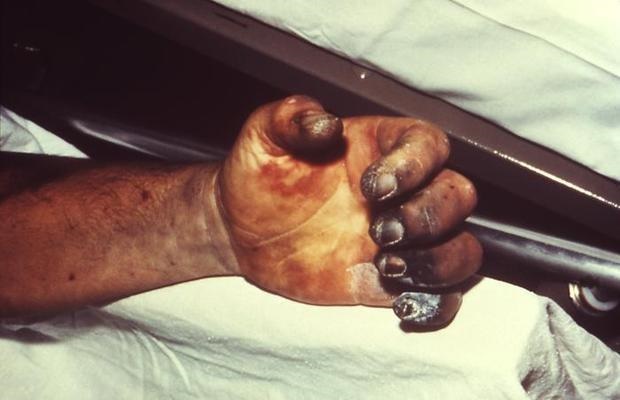
Summary
- Plague is caused by a bacterium, which infects wild rodents and their fleas.
- It spreads to humans through the bites of infected fleas.
- The characteristic sign of plague is a bubo, or swelling of a lymph node.
- Septicaemic plague can infect the bloodstream, while pneumonic plague (in the lungs) is particularly dangerous.
- Plague can be treated with antibiotics in the early stages, although death will still occur in some cases.
- If untreated, plague mortality rates are very high.
Alternative names
- Bubonic plague
- Septicaemic plague
- Pneumonic plague
- The "Black Death"
What is Plague?
Plague is one of the oldest diseases known to humans, and outbreaks still occur around the world, usually in areas where housing and sanitation conditions are poor.
Plague is caused by a bacterium which infects wild rodents and the fleas that feed off them. It spreads to humans through flea bites. The characteristic sign of plague is a bubo, or swelling of a lymph node.
Plague can be a fatal disease. Untreated, mortality rates are high. When promptly treated with antibiotics, plague can be managed, although the mortality rate remains about 15%.
What causes Plague?
Plague is transmitted from rodent to rodent by the bites of fleas infected with the Yersinia pestis bacterium. It is present in wild populations of rodents and normally doesn't cause mass death. However, if the rodent population is reduced by some other disease, hungry fleas may move on to humans and other animals, spreading the plague.
People get plague by being bitten by an infected flea, or, rarely, by direct contact with tissue or fluid from an infected animal. Usually rats and rat fleas are involved in outbreaks in human populations.
What are the symptoms of Plague?
Plague infection takes three forms:
- bubonic
- septicaemic
- pneumonic
Flea bites usually result in the bubonic form of plague, which is the most common. Bacteria infect the lymphatic system (part of the immune system) and a lymph node will become inflamed and swollen - the "bubo", for which the disease is named. Within a few days, the patient will develop flu-like symptoms, followed by the appearance of the bubo. These symptoms include:
- Fever
- Headache
- Chills
- Weakness and exhaustion
If caught early, bubonic plague can be treated with antibiotics and does not easily spread from person to person.
From the lymphatic system, bacteria can enter the bloodstream and multiply, causing septicaemic plague. This form of plague can be contracted through a flea or rodent bite, or it can develop from untreated bubonic or pneumonic plague. No bubo develops, but other symptoms include:
- Fever
- Chills
- Weakness
- Abdominal pain
- Shock
- Internal bleeding
Untreated, septicaemic plague can be fatal, but early treatment with antibiotics reduces the mortality rate to below 15 percent.
Pneumonic plague, the most serious form, occurs when bacteria enter the lungs. This happens if someone inhales airborne droplets of bacteria, or if bubonic or septicaemic plague spreads to the lungs. Symptoms usually develop within a few days of exposure. These include:
- Pneumonia (shortness of breath, chest pain, cough, bloody sputum)
- Fever
- Headache
- Weakness
Pneumonic plague is transmitted from person to person via coughing. Without diagnosis and antibiotic treatment, the patient can die within a few days, and mortality rates are very high.
How is a diagnosis made?
A doctor will suspect the presence of plague if the patient has a swollen, tender and painful lymph gland, as well as fever, chills, headache and exhaustion, and if they may have been exposed to infected rodents, rabbits or fleas.
This diagnosis can be confirmed by laboratory tests on blood, sputum, or lymph fluid.
How is it treated?
As soon as laboratory tests have confirmed the diagnosis, the patient should be treated with antibiotics - usually streptomycin or gentamycin.
What is the prognosis?
Antibiotics are usually effective against plague, but if an infected person is not treated promptly, the disease will cause illness and possibly death. If plague is diagnosed and promptly treated, the mortality rates is about 15%; untreated, mortality rates range from 50% to 90%.
Complications
If plague patients are not given antibiotic therapy, the disease can progress rapidly to death. When bubonic plague is left untreated, it can develop into more serious septicaemic and pneumonic forms of the plague.
When to call your doctor
You should see your doctor if you notice swollen lymph glands or any of the other symptoms of plague, particularly if you have been in contact with potentially infected rodents or fleas.
How can it be prevented?
Because plague - particularly pneumonic plague - is a contagious disease, an infected patient needs to be isolated, and local health authorities should be immediately informed of an outbreak, to prevent spreading.
People who have been exposed, especially those who have been in close contact with a patient with pneumonic plague, should be observed and, if appropriate, given preventive antibiotic therapy.
Other preventive measures include control of rat and flea populations.




 Publications
Publications
 Partners
Partners















